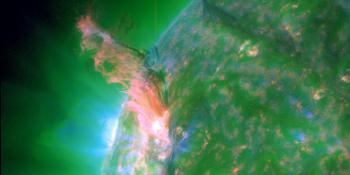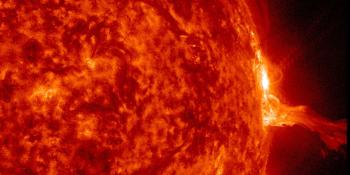Visualizzazione archivio di martedì, 20 maggio AM
Daily bulletin on solar and geomagnetic activity from the SIDC
Emesso: 2025 May 20 1231 UTC
SIDC Forecast
Brillamenti solari
C-class flares expected, (probability >=50%)
Geomagnetism
Active conditions expected (A>=20 or K=4)
Protoni solari
Quiet
| 10cm flux | Ap | |
|---|---|---|
| 20 May 2025 | 118 | 013 |
| 21 May 2025 | 119 | 013 |
| 22 May 2025 | 120 | 015 |
Solar Active Regions and flaring
Solar flaring activity over the last 24 hours has been low, with only a few C-class flares. The strongest flare was a C5.3 flare peaking at 05:54 UTC on May 20, associated with SIDC Sunspot Group 503 (magnetic type beta). There are currently seven numbered active regions on the solar disk. The most complex one is SIDC Sunspot Group 496 (NOAA Active Region 4087, magnetic type beta-delta). SIDC Sunspot Groups 502 and 503 (both magnetic type beta) have rotated on disk from the east limb, in the southeast quadrant. Solar flaring activity is expected to be low over the next 24 hours, with C-class flares expected and a small chance for M-class flares.
Espulsioni di massa coronale
A faint prominence eruption was observed in SDO/AIA 304 data around 07:40 UTC on May 20, over the northeast limb. A filament eruption was observed in SDO/AIA 304 data around 08:00 UTC on May 20, west of SIDC Sunspot Group 496 (NOAA Active Region 4087). No associated Coronal Mass Ejection (CME) was observed for either event in the available coronagraph imagery. No other Earth-directed CMEs were observed in the available coronagraph imagery.
Fori coronali
The elongated, mid-latitude, positive polarity coronal hole (SIDC Coronal Hole 104) continues to cross the central meridian since May 15.
Vento solare
The solar wind conditions (ACE and DSCOVR) were enhanced during the past 24 hours, most likely due to the continuous influence of a high- speed stream from the southern, positive polarity coronal hole (SIDC Coronal Hole 104). The solar wind speed ranged between 480 km/s and 550 km/s. The interplanetary magnetic field values increased from 5 nT to 9 nT. The Bz component ranged between -8 nT and 7 nT. The interplanetary magnetic field angle phi was predominantly in the positive sector. Further enhancements in the solar wind conditions may be expected over the next 24 hours, under the continuous influence of the high-speed stream from the southern, positive polarity coronal hole (SIDC Coronal Hole 104).
Geomagnetism
Geomagnetic conditions globally were initially at quiet levels (NOAA Kp 2- to 2+) over the past 24 hours, reaching unsettled levels (NOAA Kp 3) between 03:00 UTC and 12:00 UTC on May 20. Geomagnetic conditions locally were mostly at quiet levels (K BEL 2), with a few intervals of unsettled levels (K BEL 3). Mostly unsettled to active levels, with a small chance for isolated minor storm intervals (NOAA Kp 3 to 5, K BEL 3 to 5), are expected over the next 24 hours, under the continuous influence of the high-speed stream from the southern, positive polarity coronal hole (SIDC Coronal Hole 104).
Proton flux levels
The greater than 10 MeV proton flux was below the 10 pfu threshold over the past 24 hours. It is expected to remain below the threshold level over the next 24 hours.
Electron fluxes at geostationary orbit
The greater than 2 MeV electron flux measured by GOES 18 was over the 1000 pfu threshold between 14:50 UTC on May 19 and 03:40 UTC on May 20. The greater than 2 MeV electron flux measured by GOES 19 was over the 1000 pfu threshold between 14:00 UTC and 23:50 UTC on May 19. The greater than 2 MeV electron flux is expected to be above the 1000 pfu threshold over the next 24 hours. The 24-hour electron fluence is presently at normal levels but is expected to gradually increase over the next 24 hours.
Today's estimated international sunspot number (ISN): 082, based on 20 stations.Solar indices for 19 May 2025
| Wolf number Catania | 084 |
| 10cm solar flux | 117 |
| AK Chambon La Forêt | 014 |
| AK Wingst | 014 |
| Estimated Ap | 013 |
| Estimated international sunspot number | 071 - Based on 26 stations |
Noticeable events summary
| Day | Begin | Max | Fine | Loc | Strength | OP | 10cm | Catania/NOAA | Radio burst types |
|---|---|---|---|---|---|---|---|---|---|
| 19 | 0813 | 0821 | 0826 | ---- | M3.2 | --/---- | III/2 |
Provided by the Solar Influences Data analysis Center© - SIDC - Processed by SpaceWeatherLive
Tutti gli orari in UTC
<< Vai alla pagina della panoramica giornaliera
Ultime notizie
Ultimi messaggi dal forum
Supporta SpaceWeatherLive.com!
Molte persone vengono su SpaceWeatherLive per seguire l'attività del Sole o sapere se ci sia la possibilità di vedere l'aurora, ma a maggior traffico corrispondono costi maggiori. Considerate una donazione se vi piace SpaceWeatherLive così che possiamo mantenere online il sito web!

Notizie sul meteo spaziale
| Ultimo brillamento X | 2025/05/25 | X1.1 |
| Ultimo brillamento M | 2025/05/25 | M8.9 |
| Ultima tempesta geomagnetica | 2025/05/17 | Kp6+ (G2) |
| Giorni senza macchie | |
|---|---|
| Ultimo giorno senza macchie | 2022/06/08 |
| Media mensile Numero di Macchie Solari | |
|---|---|
| aprile 2025 | 140.6 +6.4 |
| maggio 2025 | 74.5 -66.1 |
| Ultimi 30 giorni | 82.6 -36.8 |


